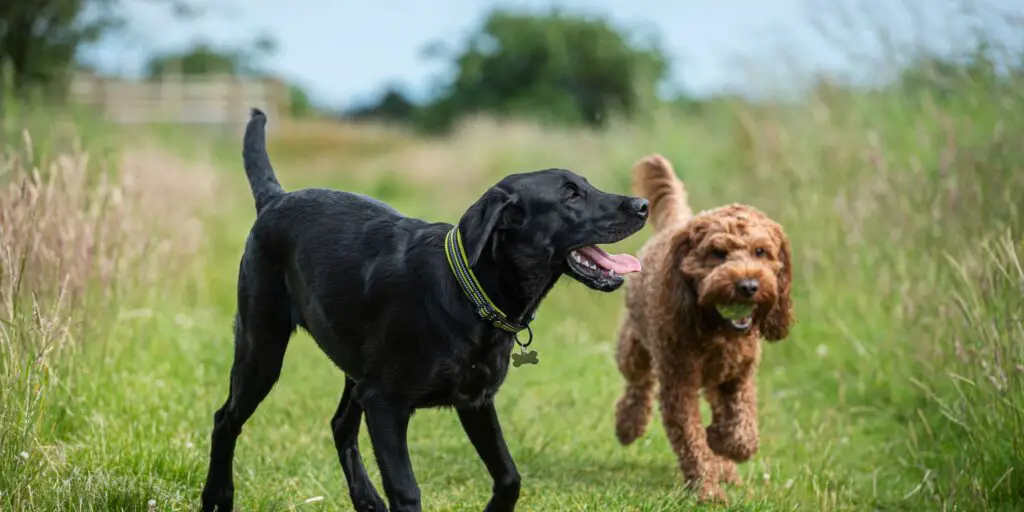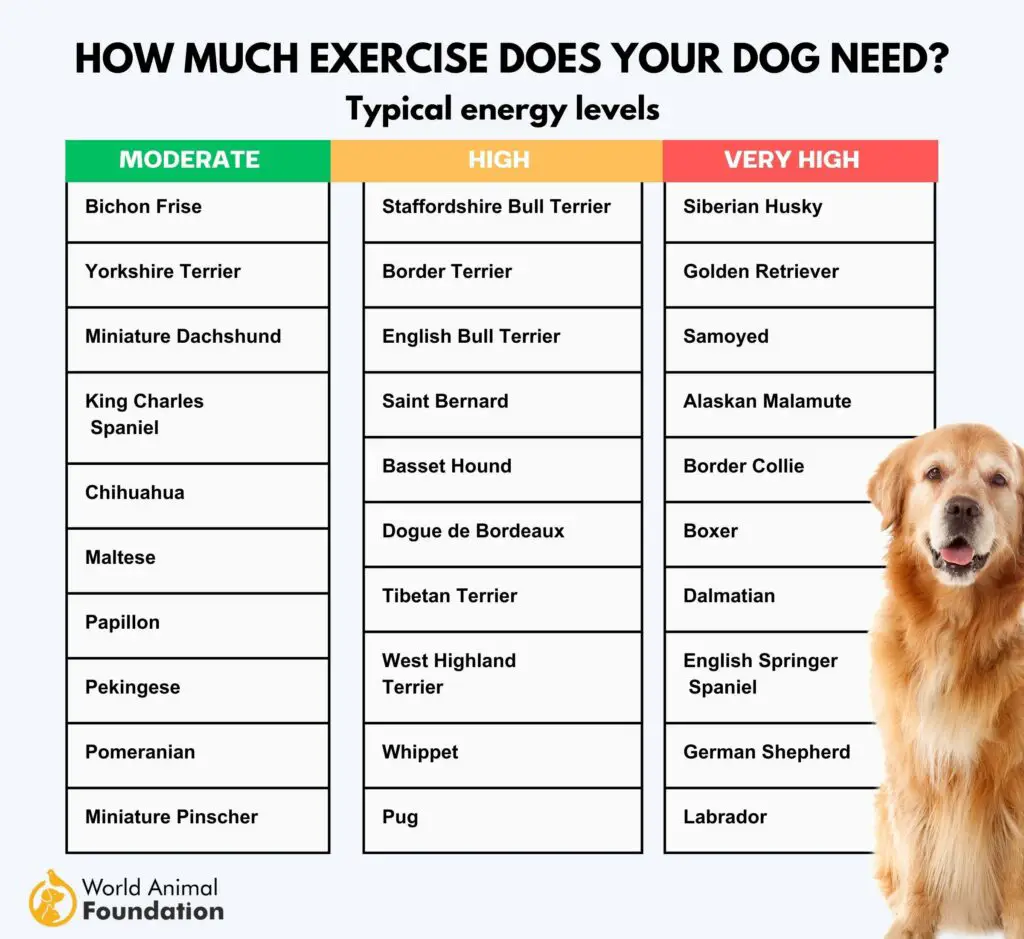Ensuring your furry friend gets enough exercise is crucial for their physical and mental well-being. But how much is enough? A dog’s exercise needs vary greatly depending on breed, age, and individual personality. Our Dog Exercise Calculator takes the guesswork out of providing optimal activity levels. By considering key factors, this tool helps you determine a personalized exercise plan, preventing boredom, promoting health, and strengthening the bond you share with your canine companion. Give your dog the gift of a happy, healthy life – calculate their ideal exercise routine today!
Disclaimer:The calculations and information provided by these tools are for educational purposes only and not a substitute for professional advice. Always consult a qualified expert before making any decisions based on these tools’ results.
Ever caught your furry friend sprinting in delightful “zoomies” around the living room or gently lazing on a sunny patch, making you wonder, how much exercise does my pupper truly need? Every doggo, whether a tireless Border Collie or a laid-back Bulldog, has its unique rhythm and energy level.
Let’s embark on a tail-wagging journey with our dog exercise calculator to unveil the magic number that keeps your pet’s tail wagging, heart thriving, and paws pacing healthily!
Dog Exercise Needs Calculator
Select Breed:
Affenpinscher
Airedale Terrier
Akita (Japanese and American)
American Bulldog
Australian Labradoodle (Mini)
Australian Labradoodle (Medium)
Australian Labradoodle (Standard)
Australian Shepherd
Basset Hounds
Beagle
Belgian Shepherd (Groenendael)
Belgian Malinois
Belgian Tervueren
Bernese Mountain Dog (BMD)
Bichon Frise
Blue Heeler
Border Collie
Border Terrier
Boston Terrier
Bouvier des Flandres
Boxer dog
Brussels Griffon
Bullmastiff
Cairn Terrier
Cane Corso
Cavalier King Charles Spaniel
Cavapoo (Cavoodle)
Cattle Dog
Chesapeake Retriever
Chihuahua
Chow Chow
Cockapoo
Cocker Spaniel (American)
Cocker Spaniel (English)
Corgi
Curly Coat Retriever
Dachshund
Dalmatian
Doberman
Dogue de Bordeaux (French Mastiff)
English Bulldog
English Pointer
English Setter
Flat-Coated Retriever
Fox Terrier (Wire)
Fox Terrier (Smooth)
French Bulldog
German Shorthair Pointer (GSP)
German Shepherd
Giant Schnauzer
Great Dane
Greyhound
Goldendoodle (Mini)
Goldendoodle (Standard)
Golden Retriever
Gordon Setter
Husky
Irish Setter
Jack Russell
Japanese Spitz
Labradoodle (Mini)
Labradoodle (Medium)
Labradoodle (Standard)
Labrador Retriever
Lhasa Apso
Leonberger
Lurcher
Malamute
Maltese
Mastiff
Miniature Schnauzer
Miniature Pinscher (Min Pin)
Miniature Poodle
Newfoundland
Old English Sheepdog (OESD)
Pitbull
Pomeranian
Pug
Rat Terrier
Rhodesian Ridgeback
Rottweiler
Rough Collie
Saint Bernard
Samoyed
Schipperke
Shar Pei
Shetland Sheepdog (Sheltie)
Shiba Inu
Shih Tzu
Soft Coated Wheaten Terrier
Springer Spaniel
Staffy
Standard Poodle
Standard Schnauzer
Toy Poodle
Vizsla
Yorkshire Terrier
Westie
Weimaraner
Whippet
Enter Age (in months):
Select Size:
Small
Medium
Large
Select Temperament:
Timid
Chilled
Lovely
Calculate
Invalid input. Please enter a valid age and breed.
Factors Influencing the Exercise Needs of a Dog
Together, the following factors create a holistic picture of your dog’s exercise needs, ensuring they stay healthy, happy, and active throughout their lives. Always remember to consult with a veterinarian when in doubt about your pup’s exercise regimen. Let’s delve deeper into the various factors that influence the exercise needs of a dog:
Dog’s Weight
Just as in humans, a dog’s healthy weight plays a pivotal role in determining its exercise needs. Overweight dogs might require weight management with fewer calories plus more activities to help shed those extra pounds. However, it’s essential to ensure that the weight loss program is gradual and safe to avoid putting too much strain on their joints and heart.
Conversely, underweight dogs need controlled, moderate exercise combined with a nutritious diet to ensure they fall within a healthy weight range of their respective dog’s breed.
Dog’s Energy Level
Every dog is unique when it comes to energy levels. Breeds like Border Collies or Jack Russell Terriers are high-energy and require ample exercise, often involving tasks that mentally stimulate them. On the other hand, Bulldogs, Shih Tzus, or a similar breed are typically lower in energy and might be content with shorter, less strenuous activities.
Dog’s Health
A dog’s health conditions can greatly influence the amount and type of exercise they need. For instance, a dog with arthritis might benefit from gentle, low-impact exercises like swimming. In contrast, dogs with heart issues need a vet-approved exercise regimen to ensure they aren’t over-exerted.
Always consult with a veterinarian when adjusting exercise routines for health reasons.
Dog’s Age
Age is the final factor and a significant determinant of exercise requirements. Puppies are bundles of energy but also have growth plates that haven’t fully closed, requiring careful moderation of their physical activity to prevent injuries.
Adult dogs, depending on their energy levels and health, often require regular, consistent exercise to avoid obesity. Senior dogs with potential health issues and lower energy levels might need gentler and shorter exercise sessions. Interestingly, you can easily find out your furry friend’s age in human years with our dog age calculator.
How Much Exercise Does a Dog Need Daily
Exercise is an essential aspect of a dog’s well-being, catering to both their physical health and mental stimulation. Most dogs love going out for walks and other activities like playing fetch. The exercise needs of dogs vary, with some requiring 1-2 hours per day, while other dogs, like working breeds, need over 2 hours, along with regular mental stimulation throughout the day.
However, the exact amount varies greatly based on the dog’s size, age, breed, and overall health.
Puppy Exercise Needs
With their boundless energy, puppies may seem like they have an insatiable appetite for play. However, their bones and joints are still growing. A general guideline is five minutes of exercise per month of age, up to twice a day.
For instance, a 4-month-old puppy would benefit from 20 minutes of exercise twice a day. It’s essential to provide varied gentle intensity activities, including short leash walks in a park and playtime, but avoid strenuous or high-impact activities that might stress their developing bodies.
You can estimate your puppy’s adult weight with our puppy weight calculator to get a better understanding of their growth and development,
Adult Dog Exercise Needs
The exercise needs of adult dogs vary considerably based on their breed, size, and health. For instance:
- Active breeds like Border Collies or Labrador Retrievers might require over 2 hours of activity daily, incorporating both physical and mental stimulation.
- Low-energy breeds like Bulldogs or Basset Hounds might be content with 30 minutes to an hour of exercise daily.
Regular activities like walks, fetch, agility training, or even dog sports can be great for adult dogs. Ensure the activities suit the particular needs and energy levels of the dog’s breed.
Senior Dog Exercise Needs
As dogs age, they might become less active and more prone to health problems like hip dysplasia. While their desire for prolonged physical activity might decrease, regular, low-impact activity remains crucial to maintain joint flexibility, muscle tone, and overall well-being. Low-impact exercises like walking or swimming can be ideal for senior dogs.
It’s vital to monitor them for signs of fatigue or discomfort and adjust the routine accordingly. Regular vet check-ups can also help tailor an appropriate exercise regimen for aging dogs.
General Insight to How Much Exercise Does My Dog Need Calculator
Ensuring that our canine companions receive the right amount of physical activity is vital for their mental and physical well-being.
Just as humans require regular physical activity to remain healthy, dogs do too. Exercise benefits our four-legged friends in numerous ways.
Our dog exercise calculator offers tailored recommendations for your canine companion’s activity needs, considering factors like age, size, temperament, and dog’s breed. Now you can navigate the journey of pet ownership with confidence, ensuring your pup’s health, happiness, and vitality are prioritized.
Symptoms of Over-Exercise in Dogs
Over-exercising your dog can be just as harmful as under-exercising them. Here’s an overview of the symptoms of over-exercise in dogs:
- Extreme Fatigue: If a dog is regularly lethargic, collapses, or refuses to participate in activities it usually enjoys, this could be a sign of over-exercising.
- Muscle & Joint Pain: Continuous over-exertion can lead to muscle strains, sprains, or more serious conditions like arthritis, particularly in younger dogs or breeds prone to joint issues.
- Dehydration: Over-exercise can lead to dehydration. Signs include dry gums, increased panting, thick saliva, and lethargy. You can stay informed about your dog’s hydration needs with our dog water intake calculator for a happy and healthy pup!
- Heatstroke: Vigorous exercise in hot weather can cause heatstroke. Symptoms include excessive panting, bright red gums, thick saliva, dog vomiting, diarrhea, and a rapid dog heart rate.
- Injuries: Overworking a dog can lead to injuries, such as paw pad abrasions or more serious structural damage like cruciate ligament tears.
- Change in Behavior: Overworked dogs may show changes in behavior, such as irritability, aggression, or increased anxiety.
- Suppressed Immune System: Chronic over-exercising can lead to a suppressed immune system, making dogs more susceptible to infections and illnesses.
- Digestive Issues: Overworking a dog immediately before or after feeding can increase the risk of bloat (gastric torsion), a life-threatening condition, especially in deep-chested breeds.
It’s essential to consult with a veterinarian if you notice any of these symptoms. They can properly evaluate your pet’s health, provide appropriate care, and advise on a suitable physical exercise regimen.
Importance of Maintaining Dog’s Daily Exercise Needs
Attending to our pup’s daily exercise needs is akin to watering a plant, fostering its growth and vitality. Just as our furry companions infuse our lives with unbridled joy, wet kisses, and affectionate nuzzles, we owe it to them to ensure their days are filled with playful frolics, invigorating walks, and spirited fetch sessions.
Learning how much exercise your dog needs is crucial for a wholesome experience. Insufficient exercise can impact your dog’s behavior, leading to destructive tendencies such as excessive barking, digging, or chewing on your belongings, as they are unable to release their boundless energy.
Keeping them active is more than just a physical endeavor—it’s a dance of love that nourishes their soul, keeps their spirits high, and deepens the bond we share, allowing us to create a tapestry of cherished memories and ensuring they lead a life as vibrant and joyful as the moments they bring into ours.
FAQs
Which breeds need the most exercise?
Breeds such as Border Collies, Australian Shepherds, Labrador Retrievers, and Siberian Huskies typically require the most exercise as they have lots more energy levels due to their working backgrounds.
Which dog breeds need the least exercise?
Breeds like Bulldogs, Basset Hounds, Shih Tzus, and Pugs are among those that typically require less exercise and are more content with shorter, less strenuous activities.
Conclusion
Understanding how much exercise your individual dog needs is pivotal in the heartwarming journey of companionship with our four-legged friends. Our dog exercise calculator provides a tailored insight, ensuring your pup’s tail wags a little brighter, their steps bounce a little lighter, and their life is filled with the joy and vitality they bring to ours.
You can uncover your pup’s life quality with our intuitive dog quality of life calculator. Here’s to happy, healthy frolics and cherished moments with our furry companions!
A dog exercise calculator provides a valuable starting point for determining your dog’s activity needs based on breed, age, and size. However, it’s crucial to remember these are just guidelines. Observe your individual dog’s behavior for signs of boredom or excess energy. Adjust their exercise routine accordingly, incorporating variety through walks, playtime, and mental stimulation. Prioritizing your dog’s physical and mental well-being ensures a happy, healthy, and well-behaved companion.


